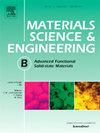Multi response optimization of synthesis of boron compounds by Dopting to graphene oxide in the Modified Hummers method
IF 3.9
3区 材料科学
Q2 MATERIALS SCIENCE, MULTIDISCIPLINARY
Materials Science and Engineering B-advanced Functional Solid-state Materials
Pub Date : 2024-11-13
DOI:10.1016/j.mseb.2024.117839
引用次数: 0
Abstract
The synthesis of graphene oxide can be improved by replacing boron compounds for NaNO3 and H3PO4 in the Hummers technique, using the TOPSIS-Based Taguchi method, which was employed to analyze multiple responses. L9(34) experimental design with four parameters and three levels was used to describe how boron compounds are used in the Hummers technique of synthesizing graphene oxide. The parameters chosen for each 2 g graphite amount, include the specific boron compound, the quantity of boron compound, the quantity of sulfuric acid, and the quantity of potassium permanganate. Seven quality criteria have been established to conduct parameter effect analysis. Raman analysis was conducted to determine the ratio of D peak intensity to G peak intensity (ID/IG) and 2D peak intensity to G peak intensity (I2D/IG), SEM + EDS was used to measure the atomic ratio of carbon to oxygen (C/O), BET analysis was employed to measure the surface area (SA), XRD analysis was performed to measure crystallite (Cs), ZETA-SİZER analyses were performed to measure Zeta Potenital (ZP) and Particle Size (PS) analyses and FTIR analysis was used for structure characterization. A reference experiment was conducted using H3PO4 in the Hummers method, and the recovery rates were documented. L9(34) The results of the best quality criteria in the design of the experiment, and improvement rates were calculated based on the reference experiment. The improvement rates calculated according to the quality criteria are for ID/IG, I2D/IG, C/O, SA,Cs,ZP and PS respectively 5 %, 190 %, 178 %, 74 %, 77 %, 66 %, and 30 % has been achieved.
在改良 Hummers 法中通过掺杂氧化石墨烯合成硼化合物的多响应优化
在 Hummers 技术中,用 NaNO3 和 H3PO4 替代硼化合物,可以改善氧化石墨烯的合成,采用了基于 TOPSIS 的田口方法,该方法用于分析多重响应。采用四参数三水平的 L9(34) 实验设计来描述如何在 Hummers 技术中使用硼化合物合成氧化石墨烯。每 2 克石墨量选择的参数包括特定的硼化合物、硼化合物的数量、硫酸的数量和高锰酸钾的数量。为进行参数效应分析,制定了七项质量标准。拉曼分析用于确定 D 峰强度与 G 峰强度的比率(ID/IG)和 2D 峰强度与 G 峰强度的比率(I2D/IG),SEM + EDS 用于测量碳与氧的原子比(C/O)、BET 分析用于测量表面积 (SA),XRD 分析用于测量晶粒 (Cs),ZETA-SİZER 分析用于测量 Zeta 电位 (ZP) 和粒度 (PS) 分析,傅立叶变换红外分析用于结构表征。在 Hummers 方法中使用 H3PO4 进行了参考实验,并记录了回收率。L9(34) 实验设计中最佳质量标准的结果,以及根据参考实验计算出的改进率。根据质量标准计算出的改进率为:ID/IG、I2D/IG、C/O、SA、Cs、ZP 和 PS 分别达到了 5%、190%、178%、74%、77%、66% 和 30%。
本文章由计算机程序翻译,如有差异,请以英文原文为准。
求助全文
约1分钟内获得全文
求助全文
来源期刊
CiteScore
5.60
自引率
2.80%
发文量
481
审稿时长
3.5 months
期刊介绍:
The journal provides an international medium for the publication of theoretical and experimental studies and reviews related to the electronic, electrochemical, ionic, magnetic, optical, and biosensing properties of solid state materials in bulk, thin film and particulate forms. Papers dealing with synthesis, processing, characterization, structure, physical properties and computational aspects of nano-crystalline, crystalline, amorphous and glassy forms of ceramics, semiconductors, layered insertion compounds, low-dimensional compounds and systems, fast-ion conductors, polymers and dielectrics are viewed as suitable for publication. Articles focused on nano-structured aspects of these advanced solid-state materials will also be considered suitable.

 求助内容:
求助内容: 应助结果提醒方式:
应助结果提醒方式:


